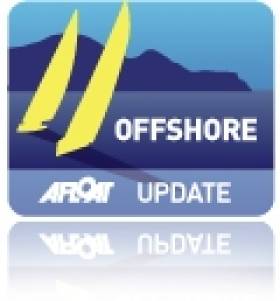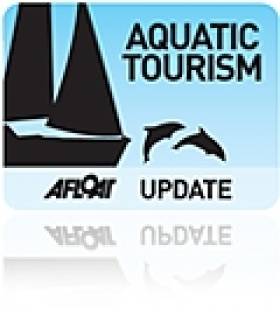Displaying items by tag: Aaron O'Grady
Four Irish On World's Largest Carbon Yacht for Caribbean 600
#CARIBBEAN 600 – A plan to secure line honours at the Caribbean 600 race on the world's largest carbon composite sailing yacht includes four Irish sailors on the 29–man crew. The Royal Ocean Racing Club race route circumnavigates 11 Carribbean islands and begins on February 20th.
The crew on the 200 foot long yacht is composed of many Volvo ocean race and Americas cup veterans and also includes Irish sailors James Caroll, Johnny Mordant, Aaron O'Grady and Mark O'Reilly.
The 67–metre yacht Hetairos was launched on June 2011 in Finland and last year the massive entry won line honours and finished second overall in the IMA Superyacht transatlantic race between Tenerife and the BVIs.
Hetairos is 200 feet long and carries up to 4400 Square metres of sail area.
With less than one month to go, to the fourth edition of the RORC Caribbean 600, the Royal Ocean Racing Club's 2012 programme kicks off with a sensational cast in Antigua.
The RORC Caribbean 600 is a truly international affair, with well over 500 hundred competitors from at least 24 different nations taking part. More than 30 impressive yachts are expected to take part in a high-speed, action-packed yacht race around 11 Caribbean islands. There can be few sporting events that can boast such a worldwide appeal with sailors taking part from all over the world including: Antigua, Australia, Austria, Canada, Cayman Islands, Croatia, France, Germany, Great Britain, Holland, Ireland, Italy, Japan, Malta, New Zealand, Norway, Puerto Rico, Russia, South Africa, Spain, Sweden, St. Lucia, Trinidad & Tobago, Turkey and the United States of America.

The largest yacht in the Caribbean 600 fleet will have four Irish sailors onboard: The magnificent 67m Hetairos. Credit:Hetairos/Baltic Yachts
This astounding diversity of nationalities is matched only by the astonishing array of yachts and personalities. The largest yacht competing this year is the magnificent Hetairos with a waterline length of 200'. Hetairos is the world's largest carbon composite sailing yacht. The 29 crew on board is composed of many Volvo Ocean Race, America's Cup and Jules Verne around the world veterans. Hetairos is among the favourites to take line honours, but there are several other yachts more than capable of finishing in front.
In 2011 American George David skippered Rambler 100 to smash the monohull course record, taking line honours and overall victory. David's team is back, this time with the Reichel Pugh 90, Rambler and they are unlikely to give up the title without a fight. The Spanish Volvo 70, Gran Jotti will be dwarfed by Hetairos, but the former Telefonica Black has a venomous turn of speed and is quite capable of out pacing the entire fleet. On board there is a huge wealth of talent in the form of Spanish America's Cup and Volvo Ocean Race sailors. These three are likely to be contenders for line honours, but overall victory under IRC is far more difficult to predict. A hot contender is Niklas Zennstrom's Judel/Vrolijk 72 Rán, which will be making its debut in the RORC Caribbean 600.
"For me it's very refreshing to tackle a new race and the Caribbean 600 is a real fascination," explained Hayles. "It's unlike any other offshore race in that the average leg is only about 40 miles and for a navigator there is a lot to consider. Normally, a race is all about the weather and strategy but in addition to all that, this race takes you back to the basic problem of navigating around so many rocks and islands. Looking through all the legs, there is a broad mixture of sailing angles; there is a fair bit of reaching, but it is wrong to think that is not a challenge, especially with the speed sensitivity of modern high-performance boats. The course is more like a whole stream of complex coastal races. I have to say that it is a pretty unique race."
A dazzling variety of yachts crewed by some of the world's finest will be racing this year. However, not all of the competitors are seasoned professionals. One of the smallest yachts competing this year is J/39 Sleeper, which will be raced two-handed by a father and son team. Jonty Layfield and son Jack are both RORC members and hale from Brighton, UK. Last year with a full crew, Jonty's won class at Antigua Sailing Week:
"Sailing Two-Handed with my son, I don't expect to be very competitive, we are not going to go flat out but treat the race more like a delivery trip," admitted Jonty. "I have raced double-handed with my son back in England and I have been sailing with Jack since he was about five years old, we are more like friends than father and son. The great thing about sailing is that you have to get on with it; you can't have any histrionics. Jack is working in Brazil at the moment and the RORC Caribbean 600 is a great way to spend a few days together."
Close duels are expected right through the fleet, none more so than in the Class 40s where a hard fought and close encounter is expected. Tradewind sailing provides perfect conditions for Class 40s, with long reaches and downwind legs, these pocket rockets are capable of surfing at speeds of up to 25 knots. Peter Harding's 40 Degrees has Hannah Jenner as skipper, the only female to skipper the Clipper Round the World Race. Hannah was in fine form last year, gaining a podium position in the Class 40 Transat Jacques Vabre:
"Antigua is a beautiful place to start the season with some winter sunshine and I have heard that Antigua Yacht Club provides a great party!" smiled Hannah. " The race course has plenty of activity with sail changes and the competition should be really close. Making the right tactical decisions will also be very important if we are to be the fastest Class 40 around the track. I am really looking forward to the race."
Hannah Jenner on Peter Harding's 40 Degrees in the 2011 Transat Jacque Vabre/ Credit: Alexis Courcoux
RORC Chief Executive Eddie Warden Owen believes that the RORC Caribbean 600 is especially attractive to larger yachts, however the ethos of the club maintains equal status to every participant.
"A wide spectrum of yachts and competitors has decided that this is an event that is not to be missed. The club is delighted that people from all over the world want to take part. There is a mixture of world class sailors and corinthian enthusiasts, but they all have one thing in common, a passion for offshore racing."
"This average length of yacht for this year's entry is over 70'. When the Royal Ocean Racing Club started this race in 2009, we felt it would appeal to larger yachts and that has proved to be the case. This year we have a significant number of Racing Maxis, Super Yachts and Spirit of Tradition yachts. However, every yacht competing in the RORC Caribbean 600 is governed by the same set of rules. All of the competitors receive a warm welcome from the Antigua Yacht Club, regardless of their finish time or place. Since 1925, The Royal Ocean Racing Club has promoted offshore racing for all and in many ways the RORC Caribbean 600 typifies that cause."
The 2012 edition of the RORC Caribbean 600, organised by the Royal Ocean Racing Club and hosted by the Antigua Yacht Club, will start on Monday 20th February 2012.
Past Results:
RORC CARIBBEAN 600 TROPHY - IRC OVERALL
2011 - George David, Rambler 100, JK 100 (USA)
2010 - Karl C L Kwok, Beau Geste, Farr 80 (HKG)
2009 - Adrian Lee, Lee Overlay Partners, Cookson 50 (IRL)
Records:
Multihull record holder - Region Guadeloupe in 40 hours 11 mins 5 secs (2009)
Monohull record held by Rambler 100 in 40 hours 20 mins 02 secs (2011)
Business Brisk in Dun Laoghaire for Charter Yachting Company
#LEARN TO SAIL - Charter yacht trip firm GoSailing.ie is weathering the recession, as the Sunday Business Post reports.
The venture - which provides daily and corporate yacht excursions since setting up in 2000 - reacted to a shortfall in customers due to the changing ecomonic climate by relocating from Westport to Dun Laoghaire marina, where business has been brisk.
Aaron O'Grady, a veteran of the Irish Olympic sailing squad, started the business with his father Pauric, the duo investing in a 54-foot yacht The Explorer to run sailing trips off the Mayo coast, helping novices learn to sail.
They later teamed up with business manager Bref Kennedy, who says that the recreational sailing business has plenty of room to grow.
"Our main goals are trying to break the perception of sailing that pervades in Ireland and also to introduce people to the exciting world of sailing on the extremely under-used and beautiful coastline that exists right on our doorstep," said Kennedy.
GoSailing is also the only company providing a charter yacht service on the east coast, according to Kennedy, which is "amazing considering we are an island nation".
Charter yachting trips around Dublin Bay, Killiney Bay and Dalkey Sound typically go for around €35 a head for groups of 12. For more details visit GoSailing.ie.

























































